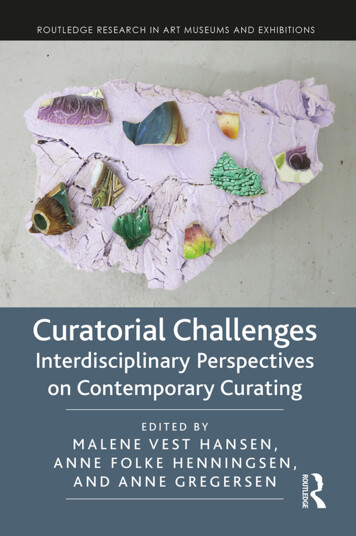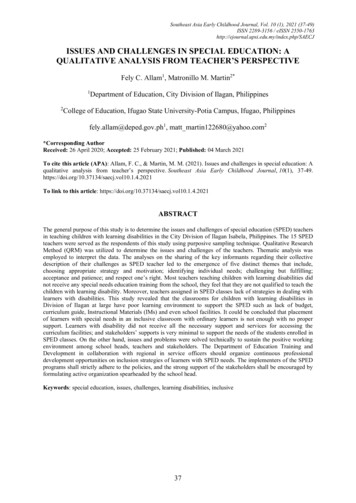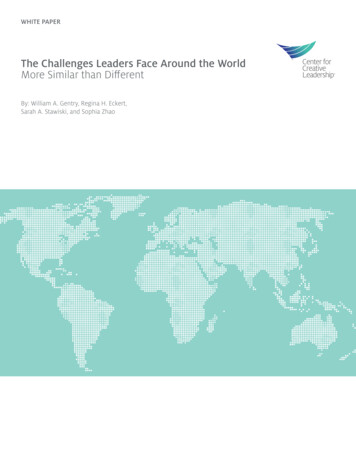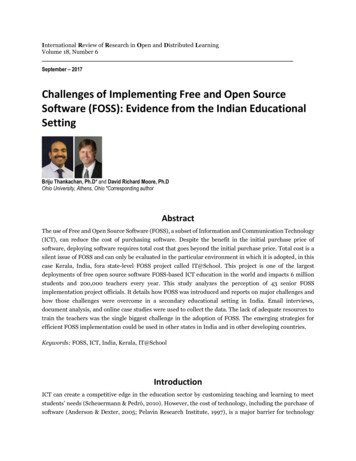
Transcription
International Review of Research in Open and Distributed LearningVolume 18, Number 6September – 2017Challenges of Implementing Free and Open SourceSoftware (FOSS): Evidence from the Indian EducationalSettingBriju Thankachan, Ph.D* and David Richard Moore, Ph.DOhio University, Athens, Ohio *Corresponding authorAbstractThe use of Free and Open Source Software (FOSS), a subset of Information and Communication Technology(ICT), can reduce the cost of purchasing software. Despite the benefit in the initial purchase price ofsoftware, deploying software requires total cost that goes beyond the initial purchase price. Total cost is asilent issue of FOSS and can only be evaluated in the particular environment in which it is adopted, in thiscase Kerala, India, fora state-level FOSS project called IT@School. This project is one of the largestdeployments of free open source software FOSS-based ICT education in the world and impacts 6 millionstudents and 200,000 teachers every year. This study analyzes the perception of 43 senior FOSSimplementation project officials. It details how FOSS was introduced and reports on major challenges andhow those challenges were overcome in a secondary educational setting in India. Email interviews,document analysis, and online case studies were used to collect the data. The lack of adequate resources totrain the teachers was the single biggest challenge in the adoption of FOSS. The emerging strategies forefficient FOSS implementation could be used in other states in India and in other developing countries.Keywords: FOSS, ICT, India, Kerala, IT@SchoolIntroductionICT can create a competitive edge in the education sector by customizing teaching and learning to meetstudents’ needs (Scheuermann & Pedró, 2010). However, the cost of technology, including the purchase ofsoftware (Anderson & Dexter, 2005; Pelavin Research Institute, 1997), is a major barrier for technology
Challenges of Implementing Free and Open Source Software (FOSS): Evidence from the Indian Educational SettingThankachan and Mooreimplementation. One solution to high software costs might be Free and Open Source Software (FOSS), as“[t]he fundamental freedom of being able to use, distribute, modify, and redistribute the modificationsmade to software released as FOSS, as well as the availability of FOSS without licensing fees and with sourcecode” (Hoe, 2006, p. 7) is leading governments, corporations, and academia to move from proprietary orcommercial software to FOSS.The latest statistics show that in 2015, there were more than 430,000 FOSS projects registered around theworld with over 3.7 million users (SourceForge, 2015). In this transition from commercial software to freesoftware, it is important to understand that FOSS has systemic effects and is more than a softwareengineering phenomenon (Feller, Fitzgerald, Hissam, & Lakhani, 2007). Even though FOSS has thepotential to enhance the education sector, the prediction of Roger’s Diffusion of Innovation is oftensubstantiated: “Getting a new idea adopted, even when it has obvious advantages, is difficult” (Rogers,2003, p. 1). This study describes a state-level project, the IT@School in India, to understand how FOSS wasimplemented; it deals with barriers faced by the Kerala education sector to implement FOSS-basedtechnologies in high schools and how it overcame those challenges.The primary research questions of this study were the following: What are the barriers and resource challenges to implementing FOSS-based education in schoolsin Kerala, India? Which strategies are employed by the IT@School project officials to overcome these barriers?BackgroundThe term Free and Open Source Software (FOSS) emerges from the convergence of two organizations, FreeSoftware Foundation (FSF) and Open Source Initiative (OSI). FSF takes a value stand on softwaredevelopment and distribution, while OSI promotes the economic and practical side of Open SourceSoftware (Free Software Foundation [FSF], 2015; SourceForge, 2015). The OSI certified softwareguarantees the right to modify, distribute, and use the software freely. In literature, the concept of FOSShas been used interchangeably as Open Source Software (OSS), Free Software, and Libre Software.However, terms such as Freeware Software and Shareware Software do not come under the FOSS definition.Shareware Software is sometimes distributed without a cost, but for full legal use, it usually requiresadditional payment and registration while the software authors retain content copyright. Similar toShareware, Freeware Software authors retain authors’ content copyright and distribute the software’s fullpotential at minimal cost and without support (Knowledge Base, 2013). Ghosh (2007) points out that manywriters in Europe use the term Free/Libre/Open Source Software (FLOSS). The United NationsEducational, Scientific and Cultural Organization (UNESCO) uses the term FOSS. The present study alsouses the term FOSS.Potential of FOSS187
Challenges of Implementing Free and Open Source Software (FOSS): Evidence from the Indian Educational SettingThankachan and MooreThe potential of using FOSS has been widely investigated. The major benefits are related to cost, reliability,extendibility, and security (Ajila & Wu, 2007; AlMarzouq, Zheng, Rong, & Grover, 2005; Surman &Diceman, 2004). Among the benefits, cost is one of the major driving forces behind the FOSS projects.Studies have shown that FOSS integration reduces costs, and this is the main motivation of the deploymentof FOSS (Ajila & Wu, 2007; AlMarzouq et al., 2005; Feller et al., 2007). In the software development field(e.g., Ajila & Wu, 2007) the FOSS-based development model reduces cost and risk and improvesproductivity and quality. The importance of localization of content, lack of customized tools for teachingand learning, and funding problems are motivating educators in Europe to embrace this technology(Gonzalez-Barahona, & Robles, 2006). FOSS also plays an important role in bridging the digital divide byproviding low-cost applications that have the ability to localize content particularly in developing countriesin Africa, Asia, and Latin America (Hoe, 2006).FOSS in Indian Educational SettingsIn India, the majority of secondary school curricula are oriented toward proprietary products (e.g. MicrosoftOffice, Visual Basic, and SQL Server). FOSS-based education is still in its infancy. However, the governmentof India and corporations are taking steps to improve the quality of education by adopting FOSS projects.Following the guiding principles of the 2005 National Curriculum Framework (e.g., connecting knowledgeoutside the classroom, enriching the curriculum beyond the textbook), several programs have been initiatedto integrate FOSS-based education in K-12 settings. The Centre for Development of Advanced Computing(C-DAC) is an Indian government agency; its open source software division develops software that can beapplied indifferent sectors. For example, in cooperation with IBM, C-DAC developed the RE portal, whichhelped to reinvent the education process in India. In cooperation with the Central Board of SecondaryEducation (CBSE) C-DAC initiated a project called Trainers Training and Student Talent Transformation.This project creates an eLearning repository for math, scienc,e and FOSS lab where students can doinnovative projects (Center for Development of Advanced Computing [C-DAC], 2015b; DEIT, 2015).In 2005, the government of India, in cooperation with the Department of Information Technology (DIT)and the Ministry of Communication and Information Technology (MCIT) established the NationalResource Centre for Free/Open Source Software (NRCFOSS). The mission of this agency is to provideresources to FOSS-related projects in the country. One of the major challenges to adopting FOSS in Indiais the lack of support staff (Sharma & Adkins, 2006). Though India has the labor force, FOSS-based trainingis lacking. To increase FOSS-trained labor force, NRCFOSS has implemented FOSS-based teaching in theengineering curriculum with a vision to produce a large number of engineering graduates with exposure,training, and skills in FOSS technologies. In addition, other certification and validation programs have beeninitiated to provide informal FOSS training. Industries are also joining to strengthen FOSS-based educationand support. For example, several companies (e.g., Red Hat, Novell, IBM, and Intel) have opened FOSSresource centers in different parts of India to provide internship programs to engineering students. Intel,in cooperation with the Department of Information Technology, has opened a FOSS resource center tointegrate ICT in curriculum development (C-DAC, 2015b; National Resource Centre for FOSS [NRCFOSS],2013).188
Challenges of Implementing Free and Open Source Software (FOSS): Evidence from the Indian Educational SettingThankachan and MooreAn example of a FOSS initiative in India is Bharat Operating System Solutions (BOSS). BOSS is an Indianversion of a GNU/Linux-based operation system (http://www.bosslinux.in), developed by C-DAC anddelivered by NRCFOSS. The desktop environment of this operating system supports 18 Indian languages;this encourages the non-English literate to adopt FOSS. BOSS has been widely used in government andeducational settings. For example, EduBoss, part of the BOSS operating system, incorporated educationalapplications (e.g., educational games, graphic tools) as well as open office, which supports 22 Indianlanguages (C-DAC, 2015a; DEIT, 2015).The Ministry of Human Resources Development (MHRD) introduced several free educational resources inrecent years. To provide universal access in secondary education, the government of India launchedRashtriya Madhyamik Shiksha Abhiyan (RMSA) in 2009. One of the objectives of the RMSA is to implementICT enabled education in secondary level education (Ministry of Human Resource Development [MHRD],2016). In 2015, the Ministry of Human Resources Development (MHRD) launched an online portal callede-basta for schools and students to browse e-books free of charge (C-DAC, 2015c). Open Source CoursewareAnimations Repository (OSCAR) provides interactive animations for math and science topics (Open SourceCourseware Animations Repositor [OSCAR], 2010). To reduce the dependency of commercial software ineducation, the MHRD started a project called Free and Open Software in Education (Free and OpenSoftware in Education [FOSSEE], 2009). National Mission on Education through ICT (NME-ICT) createde- content for master’s courses called e-PG pathshala (Information and Library Network [INFLIBNET],2016). MHRD started another project called Creating Digital Learning Environment for Design in India (‘ekalpa’) (e-Kalpa, 2016).Context of the StudyKerala is a state in India, a 392-mile-long (631 km) strip of land in the southern part of the country. Thetotal population in the state is 33,406,061. Kerala is the most literate state in India. As per the 2011 census,the effective literacy rate was 94%. Furthermore, Kerala has made remarkable progress on all socialdevelopment indicators, such as access to basic education and medical facilities (Government of Kerala,2016).Education SectorAt present, there are 12,271 schools in Kerala, 55% which are lower primary schools (LP) 24% which areupper primary schools (UP), and 21% which are high schools (HS). Among the schools, 36% are governmentschools (2551 LP, 957 UP, and 984 HS), 59% are private aided schools (4003 LP, 1870 UP, and 1409 HS),and 4% are private unaided schools (158 LP, 124 UP, and 215 HS). There are 102 teacher-training institutes,43 schools for children with special needs, and eight Anglo-Indian high schools. The State Council ofEducational Research and Training (SCERT) was established in 1994 as an autonomous organization byreorganizing the State Institute of Education (SIE) to provide academic support to general education in thestates (General Education Department, 2014).About IT@School189
Challenges of Implementing Free and Open Source Software (FOSS): Evidence from the Indian Educational SettingThankachan and MooreThe IT@School is a project under the Directorate of Public Instruction of the government of Kerala, India.This project integrates ICT as part of the teaching and learning for improvement of conventional teachingand learning systems. IT@School is one of the largest deployments of FOSS-based ICT education in theworld. The main activities of the project are capacity building, infrastructure development, contentdevelopment, and E-government. IT@School has three project partners – the government of India, IndianSpace Research Organization (ISRO), and the Department of General Education in Kerala. The governmentof India funds the project. ISRO supplies the technology for EDUSAT. The Department of Educationimplements the project. Other supporting partners for this project are BSNL, Linux, Intel, and several nongovernmental organizations (IT@School, 2014; Sadath, 2012).MethodData were collected from three sources: email interviews, document analysis, and an online case study form.In the email interview process, a senior project official was available to answer the email interviewquestions. The general idea about the project was collected through email interviews with open-ended andfocused questions about the implementation and evaluation of the project. As part of the document analysis,documents (e.g., project reports) were collected from the IT@Schools senior officials, Kerala’s educationaldepartment websites and the Ministry of Education website.An online case study form was used to collect primary data. The form was modified from the case studyform from the Office of Educational Technology (OET) of the New Hampshire Department of Education.The case study form had six sections: general information, program category, initial planning andimplementation, evaluating effectiveness, making improvements, and sharing benefits. The generalinformation section provides details about the project name, contact info, start date, and brief projectdescription. In the program category, participants were asked to indicate and rank the best category of theproject. The program categories were access to technology, technology literacy for all students, professionaldevelopment, and community.Under the initial planning and implementation category, participants were asked to rank the biggestplanning and implementation challenge. This was completed by follow-up question on how they overcamethose challenges. In evaluating effectiveness, participants were asked to rank the most effective teachingapproaches supported by the FOSS project and the data collected to evaluate the project. In addition,participants were asked to rank the essential conditions necessary for the success of the project. Thequestion “How would you change the way you implement this project in the future?” was asked in themaking improvements category. In the sharing the benefits category, the question was “Whatrecommendation do you have for schools in other states and countries interested in replicating yourproject?” The executive director of the IT@School distributed the online case study form to 60 IT@Schoolproject officials and 43 of them completed the survey.After identifying the importance or significance of each segment of information within the email interviews,documents, and case study forms, categorizing and connecting strategies were used to analyze the data(Maxwell & Miller, 2008). As part of coding, data segments were labeled and grouped by category. The five190
Challenges of Implementing Free and Open Source Software (FOSS): Evidence from the Indian Educational SettingThankachan and Moorefinal categories were the following: program category, initial planning and implementation, evaluatingeffectiveness, making improvements, and sharing benefits.ResultsSince FOSS is a subset of ICT, the barriers and resource challenges to implementing FOSS-based educationare similar to ICT as is reported in the literature. IT infrastructure (internet access) is very crucial fornational economic development and FOSS-based projects (Koria, Bartels, Köszegi, & Carneiro, 2012). Lackof support is one of the major challenges of ICT and FOSS implementation (Lai, 2006; Oliveira & Martins,2011; Woodall & Marius, 2013). Resistance to change is one of the challenges when implementing ICT andFOSS in educational settings (Howard & Mozejko, 2015; Kisanjara & Tossy, 2014). Strategies employed bythe IT@School project officials to overcome the barriers and resource challenges unique to FOSS arediscussed in detail in the section followed by major challenges.Major ChallengesIn the case study form, the researchers asked district coordinators and master trainers to rank thechallenges they had in the planning and implementation phases of FOSS. In the planning phase,infrastructure and delivery ranked first and budget ranked second. In the implementation phase, creatingeducational content ranked first, followed by resistance to change and lack of manpower. The age of theteachers was an important issue; young teachers were interested in learning new skills whereas olderteachers resisted changes in teaching. When the Department of Education incorporated FOSS in thecurriculum, adequate software to conduct IT practical exams for more than 140,000 high school studentsalso brought its own challenges. Another big hurdle was starting the educational channel ViCTERS throughthe EDUSAT network and developing educational content. Broadband connectivity was lacking in manyschool departments in the initial stage of the project. Table 1 shows a comparison of the major challengesin the planning and implementation phases.Table 1Major Challenges in Planning and Implementation of FOSSPlanning phaseImplementation ture1Creating educational content2Budget2Lack of manpower3Project risk3Resistance to change4Standards or compliance4Lack of adequate software5Other- ICT enabled material production5Lack of real-time collaboration191
Challenges of Implementing Free and Open Source Software (FOSS): Evidence from the Indian Educational SettingThankachan and MooreStrategies Used to Overcome Challenges to Implement FOSSIn the case study form, the researchers asked the open-ended question, “How did you overcome thechallenges in the planning and implementation phases?” A common theme from all the answers wasteamwork because it reduced the project risk. In the planning phase, a timeline for task management wascreated for each of the activities. In addition, ideas and responsibilities were shared among the groupmembers from time to time. The following sections discuss in depth the strategies used to overcomechallenges.Lack of Infrastructure and BudgetSchools in Kerala lack classrooms with electricity, computer labs, and telecommunication facilities. Grantsfrom state and federal agencies helped to overcome the lack of infrastructure. As project partners, thegovernment of India and the state government provide funds for infrastructure. The Indian Space ResearchOrganization (ISRO) supplies technology for satellite-based education and the government-ownedtelephone company provides broadband connection to the schools.Creating Educational ContentTeachers record their subject-related content at school level and present to students through LCDprojectors, CDs, and ViCTERS. For example, lectures of good math teachers are video -recorded and sharedwith other teachers and students in the state. In order to produce localized content, IT@School distributesa semi-professional Panasonic Handicam or video camera to each school district. The project conductsworkshops on creating educational content (lecture videos, etc.) for school teachers. Some film makersvolunteer to help with the educational department initiative to create local content. All the educationalcontent developed by the project and telecasted through ViCTERS channel is bilingual (English andMalayalam). The teachers from the Malayalam medium of instruction record the content for subjects inMalayalam. Instructors of the English medium record the content in English.Lack of ManpowerTemporary manpower was created by selecting coordinators from each school. These coordinators becameschool student IT coordinators and teacher IT coordinators. These coordinators served as the immediate ITsupport for teachers and students. Student IT coordinators teacher IT coordinators were given periodicworkshops and trainings from the IT@School. The following text is an extract from a respondent:Lack of manpower is solved by recruiting trainers on a work arrangement basis and developing oneteacher from each school as leader of all the activities of that school. By all these types of methodsnaturally the resistance became less and feeble.In addition, the project received resource personnel from the Free Software Foundation of India. To trainhigh school teachers and reduce their reluctance, the project established resource centers in Kochi, and192
Challenges of Implementing Free and Open Source Software (FOSS): Evidence from the Indian Educational SettingThankachan and MooreEDUSAT training centers in each district. In the first phase, 40,000 teachers were trained over 90 hours onLinux-based operating systems.Lack of Adequate SoftwareThe project developed a free operating system based on the Linux version Ubuntu called IT@School GNULinux. Now it has three updated versions, the latest being IT@School GNU Linux version 3. This freeplatform helped to create a single curriculum. The IT@School GNU Linux version 3 platform was createdthrough funding from the Kerala IT@mission. The Society for Promotion of Alternative Computing andEmployment (SPACE) was a solution to this problem. SPACE decided to offer support to IT@School andestablished a resource center for conducting teacher training with technical assistance.Lack of Real-Time CollaborationThe lack of real-time collaboration was due to poor connectivity. The connectivity issue was solved in threeways. Firstly, the government-managed telephone company BSNL agreed to provide broadbandconnectivity to all government schools with an annual rate per connection of Rs 5,000 ( 100). Now 20% ofthe schools have wireless connections. Secondly, as part of the national e-governance plan (NeGP), thegovernment of Kerala has a network called Kerala State Wide Area Network (KSWAN). IT@School uses thisconnectivity at a centralized level for the automation process. Finally, the EDUSAT satellite providesbroadband network to all schools through interactive IP-based technology. To facilitate this channel, thestate has 95 Satellite Interactive Terminals (SIT) and 300 Receive Only Terminals (ROT). These channelsreach households through local channels. These channels are used for video conferencing, tele-training,and distance education.Essential Conditions Necessary for Success of a ProjectParticipants were asked to respond to this statement: “From the following list, identify the essentialconditions necessary for success of your project.” Leadership and support system ranked first andinfrastructure ranked second.Project-Supported Effective Teaching ApproachesAccording to master trainers and district IT coordinators, empowering students was the most importantteaching approach, followed by fostering learners’ interactions. Flexibility ranked third and enhancingtraditional material ranked fourth. Figure 1 shows the pie chart of effective teaching approaches.193
Challenges of Implementing Free and Open Source Software (FOSS): Evidence from the Indian Educational SettingThankachan and MooreFigure 1. Effective teaching approaches.Future Plans and SustainabilityAs part of future plans and sustainability, the researchers asked the following question: “How would youchange the way you implement this project in the future?” A theme that emerged from the answers wasusing ICT-enabled education as opposed to IT-based education. From 2001 to 2010, the focus of the projectwas on IT education. In IT education, students were merely learning different functions and parts of ICT.The ICT-enabled education aims to enhance teaching and learning with more interactive tools like wikis,blogs, podcasts, and subject-based software applications. Presently, mathematics is the major content areaaddressed by the IT@School project. Future plans involve using more free software applications in othersubjects and learner-centered learning activities. The following text is an extract from a respondent’sopinion: “We plan to check out the limitations and opportunities in each school in implementing ICTeducation and take steps accordingly to provide good learning experience to students as well as to updateteachers.” Creating a research wing in the content development area is part of the project’s plan because theproject does not have this yet. The project has a centralized purchasing mechanism for purchasinghardware. These systems are helping to keep similar hardware throughout the state.The project can be sustained in the future because of its adaptability to embrace new technologies. Inaddition, the teachers are receiving refresher courses. IT content and other subjects are periodicallymodified in accordance to the curriculum to incorporate IT-enabled learning in teaching and learning. Withexpertise in the e-governance and IT training fields, the project plans to conduct certified courses in IT andis considering asking consultation fees for expertise and resource sharing. The project has already startedto implement ICT-enabled education in the primary and higher secondary level. The project has made aMemorandum of Understanding (MOU) with Intel to adopt the program called Teach to the Future forteacher training. This would create another 350 training centers in the state.194
Challenges of Implementing Free and Open Source Software (FOSS): Evidence from the Indian Educational SettingThankachan and MooreStudents’ Outcomes from the ProjectDistrict IT coordinators and master trainers stated that there is remarkable change in the classroom.Students are becoming aware of the free software and learning basic skills about using the Internet andmaintaining hardware. The following text is an extract from a respondent’s feedback response:IT@School is imparting special training to a group of students from each school as student ITcoordinators meet objectives of ICT (Information and Communication Technology) functioning inschools. These students are updating school-wiki, looking after lab maintenance, and assistingteachers and other students, thus cultivating IT leaders in the student population.The Information Technology (IT) practical exam and state IT competitions measure students’ knowledgeand skills. In the IT practical examination, 4.5 million students are evaluated every year through a freesoftware platform. The State Council of Educational Research and Training (SCRET) set up guidelines toevaluate the 10th grade IT practical examination. The practical examination is conducted by using softwarecalled “soft exam.” The yearly IT competition provides an opportunity for teachers and students to showtheir expertise in digital painting, multimedia presentation, programming, creating IT projects, and an ITquiz.ConclusionThis study identified major barriers to FOSS adoption in Indian educational settings and the strategies toovercome those barriers. Consistent with earlier studies (Brunvard, Luera, Marra, & Peet, 2010; Sarrab,Elbasir, & Elgamel, 2013; Sharma & Adkins, 2006; Woodall & Marius, 2013), the findings of this studyconfirm that the major challenges in adopting FOSS education are the lack of support systems and the needfor localization of the project. Lack of support staff trained in the FOSS is one of the major challenges toadopting FOSS in India. The proprietary software applications have support readily available due to wideadoption. In addition, the employees who trained in the Unix application find it difficult to support theLinux-based application. However, in recent years, universities are incorporating FOSS-based syllabi intheir engineering curriculum to train students to work with FOSS applications. Organizations are alsomoving into FOSS platforms that will help the industry to mature and will generate more income andeventually more efficient support systems. Localization is another major challenge in the development ofFOSS projects. However, different organizations, both government, and private companies (e.g.,BharateeyaOO, IndLinux, AnkurBangla, JanaBhaaratii) are in the process of creating the FOSS applicationsin the local languages.Pirated software and Indian work culture is another major challenge for FOSS adoption. Pirated softwareis available at a lower cost compared to the original proprietary software. In India, 70% of the software ispirated (Sharma & Adkins, 2006), which leads to little growth in the local software development market.However, India’s commitment to the World Trade Organization to protect intellectual property rights isslowly changing the situation. The rigid hierarchical form of work culture is challenging the key idea ofFOSS projects: collaboration. Collaboration is less valued in Indian work culture and the focus is on doing195
Challenges of Implementing Free and Open Source Software (FOSS): Evidence from the Indian Educational SettingThankachan and Moorethe assigned duty in an organizational structure. Due to the establishment of Western-based companies inIndia, the work culture is changing, giving more importance to innovation.In the implementation phase, creating educational content and lack of resource personnel were the firstand second biggest challenges. Seeking help from non-governmental organizations and buildingpartnerships with private firms helped the IT@School project to overcome lack of man power. Thesest
Challenges of Implementing Free and Open Source Software (FOSS): Evidence from the Indian Educational Setting Thankachan and Moore 187 implementation. One solution to high software costs might be Free and Open Source Software (FOSS), as "[t]he fundamental freedom of being able to use, distribute, modify, and redistribute the modifications


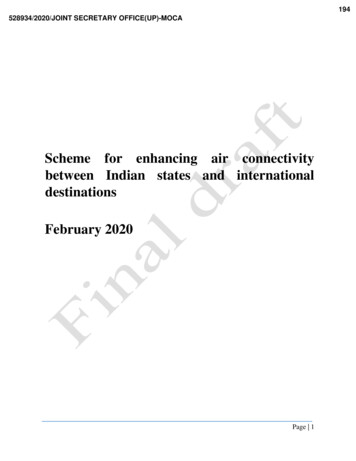
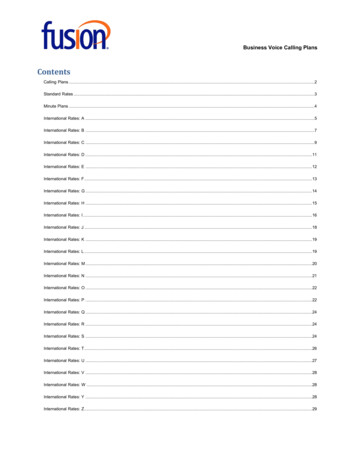
![Tamil Ilakkiya Varalaru In Tamil Pdf Free [PORTABLE] - Jbr Films](/img/63/wenslato.jpg)

